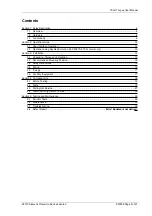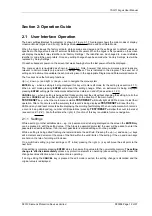
7SG11 Argus User Manual
©2013 Siemens Protection Devices Limited
P20006 Page 14 of 37
Eight settings groups are stored within the Argus. Only one of these is active at a time and only one can be
displayed at a time. Some settings have a common value across all groups. If a setting has different values
across the groups this is indicated by Gn in the top left of the display while the setting is being displayed, where n
is the number of the current display group.
The active group can be switched from one to another using the ‘Active Group’ setting in the ‘System Config.’
sub-menu. Similarly, the current display group is controlled by the ‘Display Group’ setting.
2.1.1.1 Password Entry
If, at any point, a password is required the screen will display ‘Enter password’ and a four-character field. The
password is entered, as described for settings changes above. On pressing
ENTER
, if the password is correct,
the user is “logged in” and editing will be allowed. The user will remain logged in for an hour after the last key
press after which he/she will be “logged out” and the password must be re-entered for further changes.
To change the password the ‘Change Password’ setting in the ‘System Config.’ sub-menu should be edited. If an
attempt is made to change the password the user will first be logged out and will have to log in again (to prove
authenticity). After changing the setting the user will be asked to confirm the password by re-entering it.
If no password has been set, the text ‘NOT ACTIVE’ will be shown as the setting value of the ‘Change Password’
setting. If a password has been set the setting value will be shown as either a 7 or 8 digit number. If the password
is forgotten, this 7 or 8 digit number can be communicated to Siemens Protection Devices Limited, by an
authorised person and the password can be decoded.
If a password has been set it can be removed by entering the text ‘NONE’ into the ‘Change Password’ setting.
2.1.1.2 Yes/No Confirmation
Some settings require further confirmation of change using Yes/No confirmation. When the confirmation screen
appears the edit field will be flashing
‘
N
’ (for ‘No’).
Use the up
(
)
or down
(
)
key to change the field to
‘
Y
’
(for ‘Yes’)
and then press
ENTER
to confirm the change. Pressing
CANCEL
,
or pressing
ENTER
without
changing the field to
‘
Y
’
will abort the change
.
2.1.2 Instruments
While an instrument is being displayed it will be updated regularly.
2.1.2.1 Default Instruments
When an instrument is being displayed, pressing
ENTER
toggles its “default instrument” status on and off.
A default instrument is one that is displayed automatically by the Argus after no keys have been pressed for a
period. A number of default instruments can be set in which case they will be cycled in turn for 5 seconds each.
The period before the default instruments are displayed is controlled by the ‘Default Screen Time’ setting in the
‘System Config.’ menu.
If an instrument is set as a default instrument this is indicated by a ‘
‘ in the top right corner of the display.
While a default instrument is being displayed, pressing any key (except
TEST/RESET
) will revert the display to
that being displayed before the default instrument was activated.
2.1.2.2 Resetting Counts
Some instruments show count or summation values, e.g. Trip Count, Sum of I
2
. These can be reset using settings
within the relevant sub-menus. Pressing the
TEST/RESET
key while the appropriate instrument is displayed will
also reset them. You will be asked to confirm this using a Yes/No confirmation (as described in section 2.1.1.2 but
TEST/RESET
can also be used to confirm, rather than pressing
ENTER
).
2.1.3 Fault Displays
As shown in Figure 2-1, the occurrence of a fault (as defined by the ‘Fault Trigger’ setting) will cause the red trip
LED to be lit and the trip display will be shown. This gives the date (DD/MM) and time (HH:MM:SS) of fault and
the poles that were active at the time of trip.
Example: -
12/05 17:25:51
TRIP A E
Pressing the
TEST/RESET
key will extinguish the trip LED, reset latched output relays and change the display to
the scrolling fault display, giving a more detailed fault record. On the top line of this display the fault number (1 to
5) is displayed. The bottom line gives the date and time of trip (DD/MM/YY HH:MM:SS.ssss), the active group and
then for each pole of the Argus relay:






























